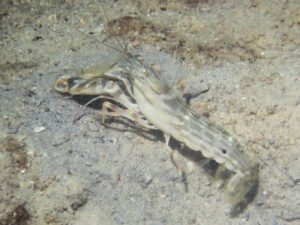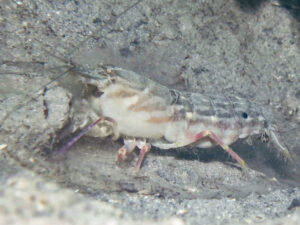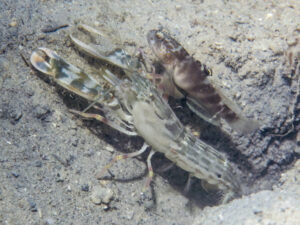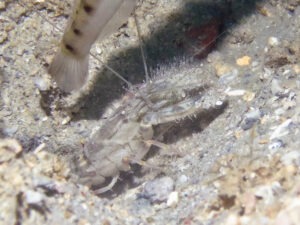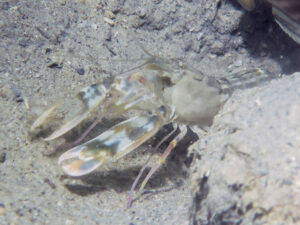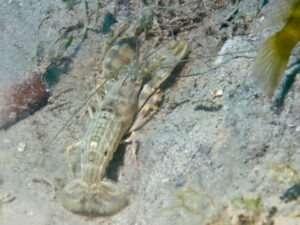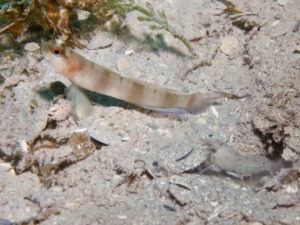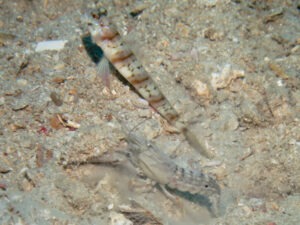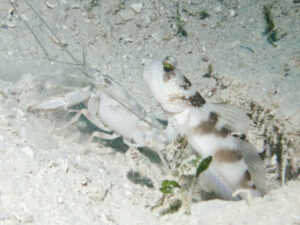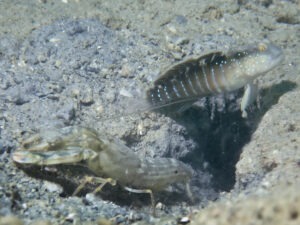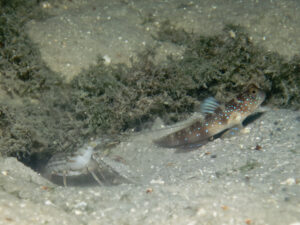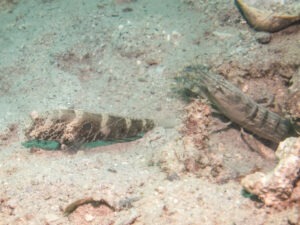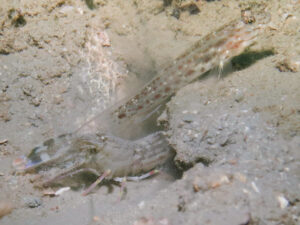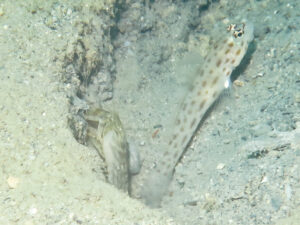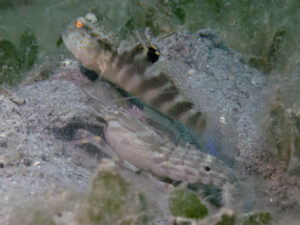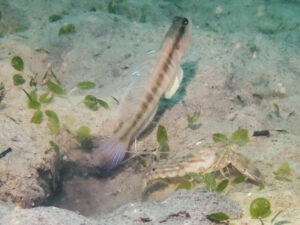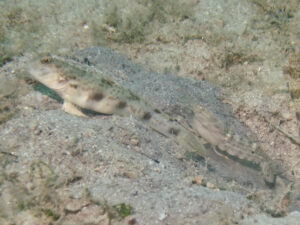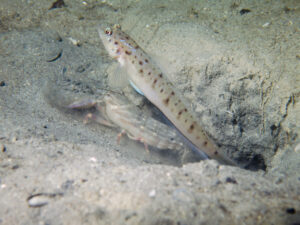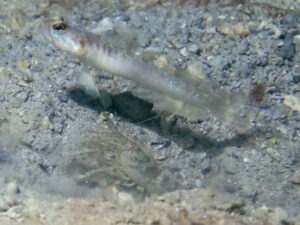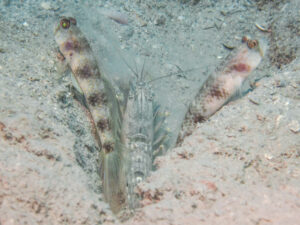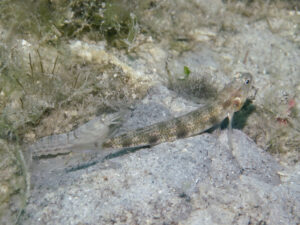Titan Snapping Shrimp
Alpheus species 15
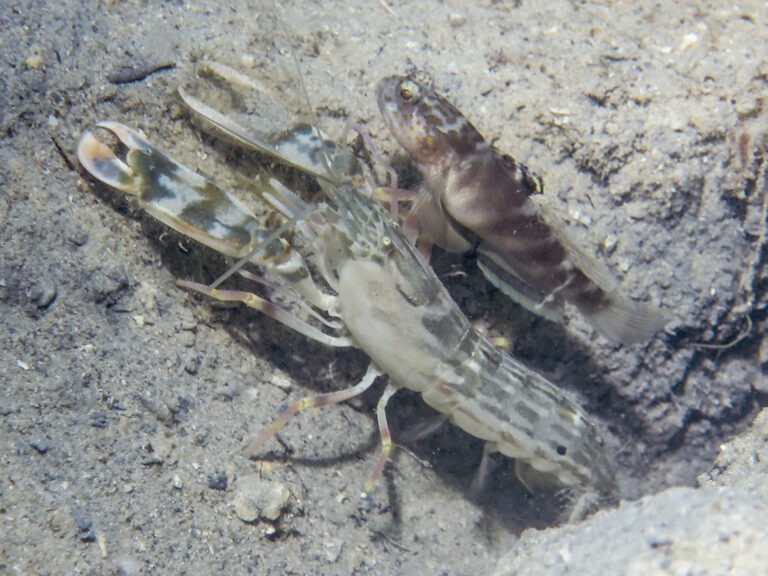
Titan Snapping Shrimp
Alpheus species 15
undescribed
Description
This is a very big, strong shrimp commonly found on silty substrate.
Carapace The dorsum of the carapace is pale grey-brown. There is a brown line in the midline running back from the level of the eyes. Lateral to this a brown patch encircles the eye and runs posteriorly until interrupted by a dorsal pale crescent-shaped mark that slopes forward to terminate in a bright pale patch laterally. Above this point is a horizontal brown line, and below there are two others that run back to become continuous with lines on the abdomen.
Abdomen The abdomen has a pale grey background with four lines of brown stripes on either side of a darker dorsal midline stripe. These stripes may be so broad that the abdomen looks red-brown with fine broken white lines rather than the other way around. The dorsal rows of white stripes are interrupted at the segment junctions resulting in a repeating segmental pattern of short dorsal white lines enclosing a short dark line. This appearance is characteristic and is most obvious on segments 1 and 4 where there is often a white transverse band as is seen in several Alpheus shrimps, though in this shrimp it is discontinuous. The lowest lateral stripe is red rather than brown. There is a black spot laterally on segment 4. There is sometimes a row of white spots between the second and third lateral stripes.
The rostrum continues the colour of the upper carapace, usually brown. The antennae are pale red-brown.
The pincers are broad, brown or grey with three well-marked dark bands the most distal of which may have a blue tinge. Pollex and dactyl are orange. The pincers become very hairy in mature males.
The chelate second leg is usually purple-blue.
The walking legs are off-white at the base, becoming red with yellow joints.
The tail fan is green-brown with a brown border and frequently hairy. The tail fan has a grey-green telson and a pale-centred endopod and proximal exopod. The distal portion of the exopod is a blue-grey transverse oval.
Variation
The appearance and size may vary even within a couple though the identifying features are constant, as the images show.
Shrimps living on darker substrates have more pigment, sometimes enough to blur the stripes on the carapace. This can make them look uniformly dark on top and pale below, especially when covered in silt as they usually are. (4315R-9072)
Identifying Features
A large grey, striped shrimp.
Lives in silty habitat, away from the reef
The characteristic pattern of interrupted pale lines on the abdomen, particularly segments 1 and 4.
Similar Shrimps
Compared to the superficially similar Diagonal Barred Shrimp the Titan Shrimp Is much bigger and has a barrel-shaped profile with the abdomen as broad as the carapace, It has more massive pincers, with well-marked transverse bands. The bars on the carapace are reddish and run more horizontally. on a background paler and more uniform than the dull grey of the Diagonal Barred Snapping Shrimp.
The Diagonal Barred Snapping Shrimp has four bands on the carapace, not two, and the dark stripes on the abdomen are better defined. In the Titan Snapping Shrimp, they are broken into a repeating series of parallel white and brown stripes on each segment of the abdomen.
Nomenclature
We have chosen not to attempt a scientific name for this species due to the amount of conflicting information we have found.
In several journal articles (e.g. Journal of Crustacean Biology vol 32 Page 694) there is a photograph taken by Anker of a similar-looking shrimp which is given the name Alpheus rapax. It corresponds well with our Titan Snapping Shrimp apart from having blue-grey legs with yellow joints instead of yellow joints with a red patch on either side.
Debelius (2001) p.151 has images of a shrimp to which he gives the name Alpheus rapax with the common name Marbled Snapping Shrimp. It looks nothing like any shrimp we have seen. (Image from Marsa Alam, Egypt).
A rapax and A rapacida are both species complexes (Anker 2001)
A rapacida is said to be easily distinguished from A rapax, Fabricius 1798, by a white band, which is not seen in A rapax. (Preston (1978). Unfortunately, the paper is not illustrated and we cannot confirm this.
Several species have a black spot laterally on segment 4. This may reflect a common ancestry but it is not mentioned in any of the popular textbooks. These “Spot-tail” shrimp are found in a variety of colour patterns. That they are different species is suggested by the fact that they do not form a continuous spectrum and that we have recorded different goby associations for the different forms.
We have not seen this shrimp form a pair with the Diagonal Barred Snapping Shrimp or any of the other shrimps described on this website.
Ecology
HABITAT
Preferred substrate Silt and sand only
Depth range 5 to 25 metres
Proximity to reef Well away from the reef edge on a flat substrate.
NATURAL HISTORY
The Natural History of this and other Pyjama Shrimps is critically tied to dep
NATURAL HISTORY
A silt specialist although tolerant of a variety of textures of sand, and algal cover. Some shrimpgobies that form partnerships with this shrimp are restricted to silty environments. Other shrimpgobies that are not restricted to silt also form partnerships with this shrimp, but only when they are living in silt
Amblyeleotris fontanesii, a silt-dwelling goby, is generally regarded as teaming up only with one specific shrimp, Alpheus fenneri, but it can be found in burrows maintained by the equally strong Titan Shrimp.
It is a large shrimp and capable of maintaining burrows for many of the larger shrimpgoby species, such as Cryptocentrus bulbiceps, Bluelined Shrimpgoby and Tomiyamichthys levisquama, Smooth-scale Shrimpgoby. Young Titan Snapping Shrimp will team up with a wide variety of medium-sized shrimpgobies.
th and habitat and is reflected in the associations each shrimp forms with the available shrimpgobies,
There is a depth demarcation between the territory of the Yellow and Brown Pyjama Shrimps. The Brown Pyjama Shrimp forms associations primarily with the shrimpgobies that favour moderate depths. They alone form a partnership with Redspotted Shrimpgoby Amblyeleotris ogasawarensis, and Broadbanded Shrimpgoby Amblyeleotris periophthalma.
The Yellow Pyjama Shrimp on the other hand associates with shallow water gobies and is the only shrimp that forms associations with the Burgundy Shrimpgoby, Amblyeleotris wheeleri and Blackchest Shrimpgoby Amblyeleotris guttata. We have no record of the brown with A wheeleri and only a single record of it with A guttata.
The Pink Pyjama shrimp overlaps the Brown in depth and has a not dissimilar habitat and yet eight of the gobies it associates with have not been seen with the Brown. The only overlap involves three species notable for the range of depth, habitat and shrimp associations they enjoy. (A steinitzi, C pomastictus, T nudus).
Distribution
Published Distribution:
Indo-West Pacific: Red Sea, Thailand, Vietnam, Indonesia, x New Guinea, Australia, Ryanskiy (2016). Indo-West Pacific: Indonesia to Australia, Humann and DeLoach (2010). Widespread Indo-Pacific, Kuiter and Debelius (2009).
Our records:
Australia; Lizard Island, Fitzroy Island, Michaelmas Cay, Low Isles, Fantome Island, Hervey Bay.
Solomon Islands; Ghizo.
Associated Goby species
Associated Shrimpgobies (15 species)
Amblyeleotris fontanesii, Giant Shrimpgoby
Amblyeleotris stenotaeniata, Thinbar Shrimpgoby
Cryptocentrus bulbiceps, Bluelined Shrimpgoby
Cryptocentrus cyanospilotus, Bluespot Saddled Shrimpgoby
Cryptocentrus fasciatus, Y-bar Shrimpgoby
Cryptocentrus strigilliceps, Target Shrimpgoby
Ctenogobiops crocineus, Silverspot Shrimpgoby
Ctenogobiops pomastictus Goldspeckled Shrimpgoby
Mahidolia mystacina, Flagtail Shrimpgoby
Myersina nigrivirgata, Blackline Shrimpgoby
Tomiyamichthys levisquama, Smooth-scale Shrimpgoby
Vanderhorstia ambanoro, Twinspot Shrimpgoby
Vanderhorstia auronotata Gold-Marked Shrimpgoby
Vanderhorstia papilio, Butterfly Shrimpgoby
Vanderhorstia phaeosticta, Yellowfoot Shrimpgoby

